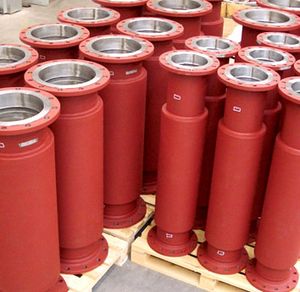District heatingpipelines

Axial expansion joints to compensate high axial expansion in district heatingpipelines.
Construction optional as an double bellow expansion joint with an inside and outside protecting pipe
Type AP / 200 / 16 / a 160 V / V-1200
DP 13 bar
DT 120° Cax. Bew. +/- 95 mm
Power plants with combined heat and power generation are being increasingly used for central, effective supply and distribution of heat in residential areas and industries. Heat supply via district heating pipes requires compensation of the thermally induced longitudinal expansion of the pipeline within the smallest space, depending on the pipeline route. In contrast to the conventional U-pipe elbow designs, the state-of-the-art expansion joints offer the advantage of a significantly smaller assembly space. Thus, underground laying in channels is no longer a problem. This is a great advantage especially in heavily built-up urban areas.
The expansion joints are produced in the standardised nominal sizes of DN50 – DN800 and nominal pressure ratings of PN6 – PN40. The axial stroke to be compensated is in the range of 50mm – 200mm. The expansion joints are pre-stressed according to the purpose of accommodating thermal expansion. This allows use of the axial stroke in a direction, mostly as compression of the expansion joint, but also as expansion.
For the integration into the pipeline, nozzles or standardised flanges according to DIN EN 1092-1 can be used.
Expansion joints are often designed with an inner guide tube and an outer protective tube for protection and axial guidance. Special designs with insulation also allow direct laying in the ground
By using multi-ply metal bellows, it is ensured thatthe service life of the expansion joint does not end with a sudden large leak, causing media and pressure loss. The multi-ply metal bellows acts like a "labyrinth seal", thus allowing only minor leaks. The replacement of such an expansion joint can then often be postponed to the scheduled inspection phase, in compliance with the work regime and environmental aspects.


